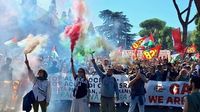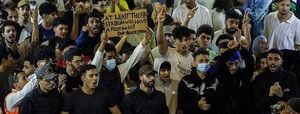On October 3, 2025, Italy came to a dramatic halt as a massive general strike swept across the country, with hundreds of thousands—by some estimates, over two million—Italians walking off the job to protest the Israeli blockade of the Global Sumud Flotilla and ongoing violence in Gaza. The strike, which began as a call to action from the grassroots union Unione Sindacale di Base (USB) and quickly grew to include some of Italy’s largest trade union confederations, marked one of the most significant displays of international solidarity for Palestine in recent European memory. According to Peoples Dispatch, protesters blocked ports, highways, and industrial zones, delivering what organizers described as a resounding rejection of Prime Minister Giorgia Meloni’s government and its perceived complicity in the Gaza conflict.
The catalyst for the strike was the Israeli Occupation Forces’ recent interception and detention of activists—including several Italians—aboard the Global Sumud Flotilla in international waters. The flotilla, a humanitarian mission aiming to break the blockade of Gaza, had drawn international attention and condemnation after its participants were detained. Italian officials, including Prime Minister Meloni, faced criticism for what many saw as a lackluster response to the crisis. Rather than intervening decisively to secure the activists’ release, the government implied Israel had acted judiciously and shifted blame onto the flotilla itself. This response, according to left-wing party Potere al Popolo, shattered the government’s self-styled image as “sovereignist” and exposed its willingness to “bow down and prostrate itself before Israel.”
Giuliano Granato of Potere al Popolo, reporting from one of the marches, told Peoples Dispatch, “Tens of thousands of people took to the streets for the general strike in support of Palestine: this is a huge success. It shows that there is a majority in the country that is fighting for Palestine and doing what our government has not dared to do for two years.” The protests were not limited to symbolic gestures. In Naples, at least 50,000 demonstrators seized part of the port, while in Bologna, 150,000 people blocked major roads. Padua saw more than 10,000 protesters occupying the industrial zone, only to be met with water cannons and tear gas by police. Despite heavy repression, the demonstrators remained steadfast. “The march stayed united and we are continuing the blockade,” one participant told Peoples Dispatch. “We want an end to complicity. We want a free Palestine.”
The demands of the strikers were clear and uncompromising: an immediate end to attacks on Gaza, the release of detained flotilla activists, a full arms embargo on Israel, and the severing of all ties with the occupation authorities. Union leaders echoed these calls, with Maurizio Landini, head of the confederation CGIL, stating, “There are no rights, there is no dignity without peace. True security does not mean increasing spending on weapons, but investing in public health, education, employment, and the redistribution of wealth.” Landini’s words, reported by Reuters and Peoples Dispatch, underscored the broader social and economic dimensions of the strike, linking the struggle for Palestinian rights to domestic concerns over austerity and militarization.
“This is not just any strike. We’re here today to defend brotherhood among individuals, among peoples, to put humanity back at the centre, to say no to genocide, to a policy of rearmament,” Landini told Reuters. The sentiment was echoed by other unionists and protesters, who called on the Italian government to prioritize the needs of ordinary people—those “who keep this country going every day, with precarious lives, low wages, and insecure jobs”—over international arms deals and alliances with Israel.
As the strike unfolded, scenes of confrontation played out in cities across Italy. In Padua, demonstrators faced aggressive police tactics, but maintained their blockade of the industrial zone. In Naples, crowds surged past police barriers to occupy strategic points of the port. Bologna’s major thoroughfares were brought to a standstill by coordinated mass action. The scale and intensity of the mobilization signaled a new phase in Italy’s labor and protest movements, one that places international solidarity at the heart of domestic struggle.
While Italian unions and grassroots organizations took bold action, the contrast with labor movements in other countries—particularly the United States—was stark. As Payday Report noted, while unions globally were striking for Palestinian rights, the U.S. labor movement had largely confined itself to symbolic gestures. Organizers argued that covering and amplifying actions like those in Italy could help persuade more unions worldwide to take direct action in support of Palestinian rights.
Preparations were already underway for a national demonstration in Rome on Saturday, October 4, 2025, with activists determined to maintain momentum and keep the spotlight on Gaza. The strike also occurred amidst a broader wave of labor unrest across Europe and beyond. In France, for instance, the Eiffel Tower was closed as nationwide strikes against austerity gripped the country. Meanwhile, in the U.S., major labor actions continued to make headlines: Boeing announced plans to hire permanent replacement workers as a strike of 3,200 fighter jet workers entered its third month, and Kickstarter United Workers began their own strike on October 2.
Other significant labor victories were also reported. Thousands of workers in TV commercial production departments secured their first union contract following the “Stand With Production” movement, and Starbucks union baristas gained new bargaining rights related to layoffs after a wave of store closures. These developments highlighted a renewed spirit of labor activism, even as challenges and setbacks—such as layoffs at GM’s Fairfax Assembly in Kansas City—remained ever-present.
The Italian general strike, however, stood out for its scale, political clarity, and internationalist message. Organizers and participants made it clear that their fight was not only against domestic austerity or wage stagnation, but also against what they saw as Italy’s complicity in global injustices. As one statement from Potere al Popolo’s Bologna chapter put it, “Let’s center our priorities around those who keep this country going every day, with precarious lives, low wages, and insecure jobs. Instead of rearmament and alliances with Israel, let’s lay down arms and raise salaries!”
With the eyes of the world on Italy, and further actions planned in Rome, the October 3 strike may well be remembered as a pivotal moment for both the Italian labor movement and the broader campaign for Palestinian rights. As the dust settled from clashes in Padua and the blockades in Naples and Bologna, one thing was clear: a significant portion of Italian society had chosen to stand up, together, for peace, dignity, and a more just world.




